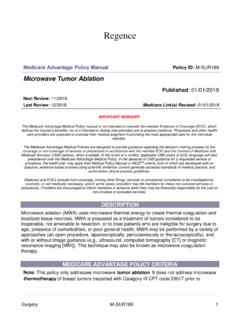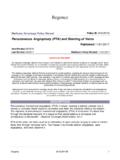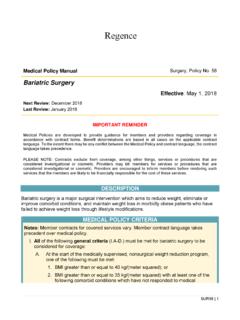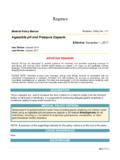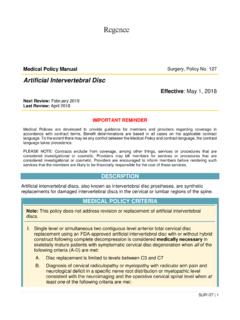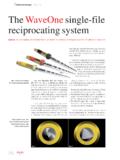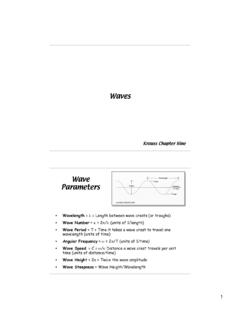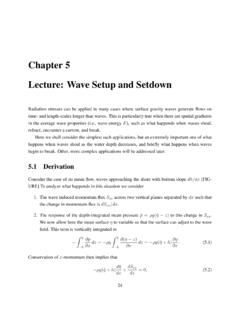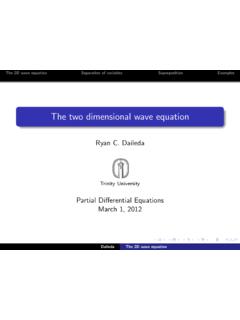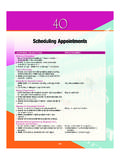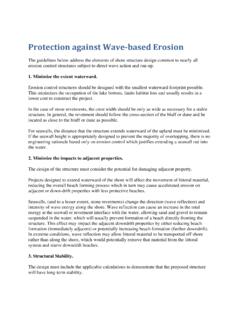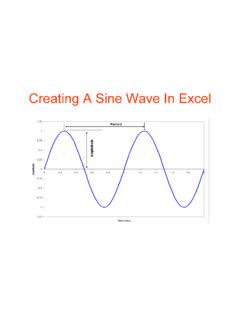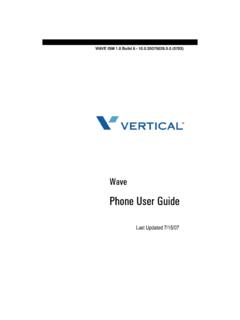Transcription of H-wave Stimulation - Regence.com
1 | 1 Medical Policy Manual Durable Medical Equipment, Policy No. H-wave Stimulation Effective: February 1, 2021 Next Review: November 2021 Last Review: December 2020 IMPORTANT REMINDER Medical Policies are developed to provide guidance for members and providers regarding coverage in accordance with contract terms. Benefit determinations are based in all cases on the applicable contract language. To the extent there may be any conflict between the Medical Policy and contract language, the contract language takes precedence. PLEASE NOTE: Contracts exclude from coverage, among other things, services or procedures that are considered investigational or cosmetic. Providers may bill members for services or procedures that are considered investigational or cosmetic. Providers are encouraged to inform members before rendering such services that the members are likely to be financially responsible for the cost of these services.
2 DESCRIPTION The proposed mechanism of H-wave Stimulation is that a bipolar, exponential decaying waveform that combines low and high frequency wavelengths may provide muscle Stimulation and analgesic pain control. H-wave electrical Stimulation must be distinguished from the H- waves that are a component of electromyography. MEDICAL POLICY CRITERIA H- wave Stimulation devices are considered investigational for all indications, including but not limited to the treatment of pain. NOTE: A summary of the supporting rationale for the policy criteria is at the end of the policy. CROSS REFERENCES None BACKGROUND REGULATORY STATUS | 2 The H-wave device has received 510(k) approval from the Food and Drug Administration (FDA) as a muscle stimulator. Approved uses for this device include: treatment of muscle spasm, deterrence or reduction of muscle disuse atrophy, and improvement of muscle range of motion, among others.
3 Uses not approved by the FDA include, but are not limited to, treatment of arthritis, migraine headaches, or diabetic neuropathy and wound healing. More than 100 electrical Stimulation devices have received 510(k) approval from the FDA. Marketing clearance via the 510(k) process does not require data regarding clinical efficacy. EVIDENCE SUMMARY The principal outcomes associated with treatment of pain due to any cause may include: relief of pain, improved functional level, and return to work. Relief of pain is a subjective outcome that is typically associated with a placebo effect. Therefore, data from adequately powered, blinded, randomized controlled trials (RCTs) are required to control for the placebo effect, determine its magnitude, and determine whether any treatment effect from an electrical Stimulation device provides a significant advantage over the placebo. Treatment with an electrical Stimulation device must also be evaluated in general groups of patients against the existing standard of care for the condition being treated.
4 For example, in patients with pain symptoms, treatment with an electrical Stimulation device should be compared with other forms of conservative therapy such as splinting, rest, non-steroidal anti-inflammatory medications, physical therapy, or steroid injection. SYSTEMATIC REVIEW A systematic review with meta-analysis, supported in part by a device manufacturer (Electronic Waveform Lab, Inc.) was published in 2008 and reported on five studies using the H-wave device for the treatment of pain.[1] However, conclusions based on this meta-analysis are limited by the lack of sufficient data from randomized, placebo-controlled studies and are based mainly upon results from case series. RANDOMIZED CONTROLLED TRIALS Two small RCTs (n=23 and31) evaluated the efficacy of H-wave electrical Stimulation in the treatment of diabetic peripheral neuropathy, and one small study evaluated the effects of H-wave Stimulation on range of motion and strength testing in patients who underwent rotator cuff reconstruction.
5 [2-4] However, the studies were unreliable due to at least one of the following reasons: The small study population limited the ability to rule out the role of chance as an explanation of findings. The attrition of study subjects and blinding was either not reported or not adequately addressed in the analysis, potentially undermining comparability of treatment groups. PRACTICE GUIDELINE SUMMARY There are no evidence-based clinical practice guidelines that recommend the use of H-wave electrical Stimulation devices. | 3 SUMMARY There is not enough research to show that H-wave Stimulation improves pain or function for people with any condition. No clinical guidelines based on research recommend H-wave Stimulation for people with any condition. Therefore, H- wave Stimulation devices are considered investigational for all indications. REFERENCES 1. Blum K, Chen AL, Chen TJ, et al. The H-wave device is an effective and safe non-pharmacological analgesic for chronic pain: a meta-analysis.
6 Adv Ther. 2008;25(7):644-57. PMID: 18636234 2. Kumar D,Marshall HJ. Diabetic peripheral neuropathy: amelioration of pain with transcutaneous electrostimulation. Diabetes Care. 1997;20(11):1702-5. PMID: 9353612 3. Kumar D, Alvaro MS, Julka IS, et al. Diabetic peripheral neuropathy. Effectiveness of electrotherapy and amitriptyline for symptomatic relief. Diabetes Care. 1998;21(8):1322-5. PMID: 9702441 4. Blum K, Chen AL, Chen TJ, et al. Repetitive H-wave device Stimulation and program induces significant increases in the range of motion of post operative rotator cuff reconstruction in a double-blinded randomized placebo controlled human study. BMC Musculoskelet Disord. 2009;10:132. PMID: 19874593 CODES Codes Number Description CPT None HCPCS E1399 Durable medical equipment, miscellaneous Date of Origin: January 2012
